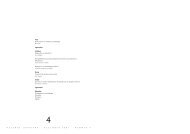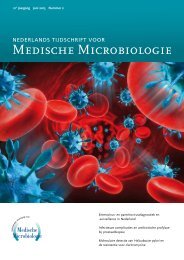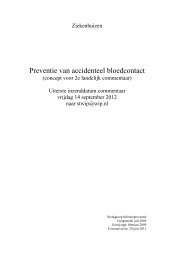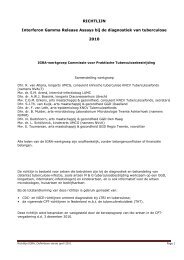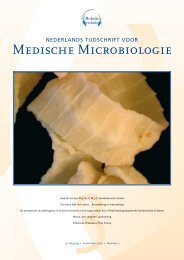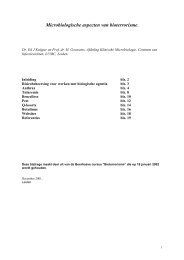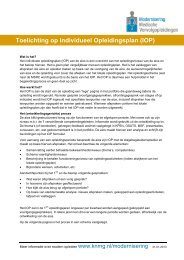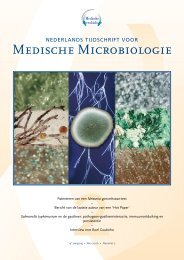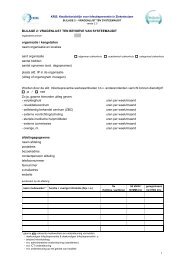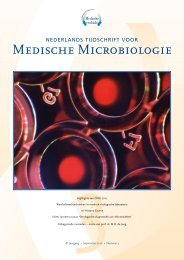Thema: Diabetes mellitus en infectieziekten Het ... - NVMM
Thema: Diabetes mellitus en infectieziekten Het ... - NVMM
Thema: Diabetes mellitus en infectieziekten Het ... - NVMM
- No tags were found...
Create successful ePaper yourself
Turn your PDF publications into a flip-book with our unique Google optimized e-Paper software.
Preval<strong>en</strong>ce in the Netherlands of OXA-48 producingE. coli and K. pneumoniae with merop<strong>en</strong>em MICsbelow the scre<strong>en</strong>breakpoint of the Dutchcarbap<strong>en</strong>emase guidelineK. van Dijk 1,2 , J. Scharringa 2 , A.C. Fluit 2 , J.M. Ossewaarde 3 ,A. van der Zee 3 , M. A. Leverstein-Van Hall 4,5 , H.A.Bijlmer 4 , M.J.M. Bont<strong>en</strong> 2 , J.W.T. Coh<strong>en</strong> Stuart 21Departm<strong>en</strong>t of Medical Microbiology, Academic MedicalC<strong>en</strong>ter, Amsterdam, 2 Departm<strong>en</strong>t of Medical Microbiology,University Medical C<strong>en</strong>ter Utrecht, Utrecht, 3 Departm<strong>en</strong>t ofMedical Microbiology, Maasstad Hospital, Rotterdam, 4 C<strong>en</strong>trefor Infectious Disease Control, National Institute for PublicHealth and the Environm<strong>en</strong>t (RIVM), Bilthov<strong>en</strong>, 5 Departm<strong>en</strong>tof Medical Microbiology, Bronovo Hospital, the HagueIn a rec<strong>en</strong>t outbreak of OXA-48 producingEnterobacteriaceae, 56% of E. coli and 25% of K.pneumoniae were scre<strong>en</strong> negative according to theDutch detection guideline (merop<strong>en</strong>em ≤ 0.25 mg/Land imip<strong>en</strong>em ≤ 1 mg/L). All isolates had ertap<strong>en</strong>emMICs ≥ 0.5 mg/L. Aim of this study was to estimate thepreval<strong>en</strong>ce in the Netherlands of scre<strong>en</strong> negative OXA-48producing E. coli and K. pneumoniae in non-outbreaksettings.All 9 Dutch laboratories using Pho<strong>en</strong>ix TM systems wereasked to s<strong>en</strong>d E. coli and K. pneumoniae isolates withmerop<strong>en</strong>em MICs ≤ 0.5 mg/L and ertap<strong>en</strong>em MICs≥ 0.5 mg/L collected betwe<strong>en</strong> January 1st 2011 andMarch 1st 2012. Species id<strong>en</strong>tification was confirmed byMaldi-ToF, and OXA-48 PCR was performed in isolateswith ertap<strong>en</strong>em MIC ≥ 0.5 mg/L, confirmed by Etest.In total, 448 isolates matched the inclusion criteria. Ofthese, 97 were available. Tw<strong>en</strong>ty-one isolates were excludedbecause of contamination or species misid<strong>en</strong>tification,leaving 76 isolates (13 K. pneumoniae and 63 E. coli), inwhich ertap<strong>en</strong>em MIC ≥ 0.5 mg/L was confirmed in 16. Ofthese, 2 E. coli isolates produced OXA-48 plus an ESBL, andmerop<strong>en</strong>em MICs were ≤ 0.25 mg/L by Etest. Both pati<strong>en</strong>tshad rec<strong>en</strong>tly traveled to the Mediterranean basin. By extrapolationusing ISIS-AR data, 29 (95%-CI: 18-40) OXA-48producing E. coli and no K. pneumoniae would have be<strong>en</strong>missed in 2011 in the Netherlands (1 per 1-2 laboratories).In conclusion, with the curr<strong>en</strong>t carbap<strong>en</strong>emase detectionguideline, the estimated number of undetected OXA-48producing E.coli and K. pneumoniae is around 29 per yearin the Netherlands.Negative rtPCR of sputum and oropharyngealwash specim<strong>en</strong>s cannot rule out diagnosis ofPneumocystis jirovecii pneumoniaJ. van Ing<strong>en</strong> 1 , T. Ar<strong>en</strong>s 1 , J. Hopman 1 , P.D.J. Sturm 11 Departm<strong>en</strong>t of Medical Microbiology, Radboud UniversityNijmeg<strong>en</strong> Medical C<strong>en</strong>tre, Nijmeg<strong>en</strong>Pneumocystis jirovecii pneumonia (PJP) is a pot<strong>en</strong>tially fatalopportunistic infection that requires invasive samplingof the lower airways by broncho-alveolar lavage (BAL)and detection of Pneumocystis jirovecii for diagnosis. Anoninvasive rule-out test to be performed in upper airwayspecim<strong>en</strong>s would be clinically useful.To assess their pot<strong>en</strong>tial as rule-out tests for PJP, weperformed real-time PCR (rtPCR) analysis of pairedsamples of sputum and/or oropharyngeal wash fluid andBAL fluid of 47 pati<strong>en</strong>ts with a high clinical suspicion ofPJP, evaluated betwe<strong>en</strong> January 2009 and January 2011.A positive rtPCR in BAL was used as a gold standard fordisease.Sev<strong>en</strong>te<strong>en</strong> pati<strong>en</strong>ts had a positive rtPCR for Pneumocystisjirovecii in BAL fluid. rtPCR of sputum samples (n = 17)showed a s<strong>en</strong>sitivity of 88%, specificity of 78%, positivepredictive value (PPV) of 78% and negative predictive value(NPV) of 88%. rtPCR of oropharyngeal wash fluid (n = 34)revealed a s<strong>en</strong>sitivity of 57%, specificity of 90%, PPV of57% and NPV of 75%.Three out of six rtPCR-positive BAL samples of pati<strong>en</strong>tswith rtPCR-negative oropharyngeal wash samples werepositive by immunofluoresc<strong>en</strong>ce. The sole rtPCR-positiveBAL sample of which the paired sputum sample wasnegative was negative by immunofluoresc<strong>en</strong>ce.In conclusion, the NPVs are insuffici<strong>en</strong>t to use rtPCR ofsputum or oropharyngeal wash samples as a rule-out testin the clinical diagnosis of PJP, using the curr<strong>en</strong>t goldstandard. Applying stricter criteria for diagnosis, includingpositive immunofluoresc<strong>en</strong>ce, rtPCR of sputum may be ofvalue as a rule-out test.As of yet unexplained supraregional emerg<strong>en</strong>ce ofcryptosporidiosis in the NetherlandsP.C. Wever 1 , I.T.M.A Overdevest 2 , B. Mulder 3 , T.G. Mank 4 ,M.H.A. Hermans 5 , J. Roelfsema 6 , J.G. Kusters 7 , J.W.Dorigo-Zetsma 8 , M. Deege 9 , L.M. Kortbeek 61 Departm<strong>en</strong>t of Medical Microbiology and Infection Control,Jero<strong>en</strong> Bosch Hospital, ’s-Hertog<strong>en</strong>bosch, 2 Laboratory forMedical Microbiology and Immunology, St. ElisabethHospital, Tilburg, 3 Laboratory of Medical MicrobiologyTw<strong>en</strong>te Achterhoek, Enschede, 4 Regional Laboratory forMedical Microbiology & Public Health, Haarlem, 5 MolecularDiagnostics, Jero<strong>en</strong> Bosch Hospital, ’s-Hertog<strong>en</strong>bosch, 6 C<strong>en</strong>terfor Infectious Disease Control Netherlands, Laboratoryfor Infectious Diseases and Perinatal Scre<strong>en</strong>ing, RIVM,Bilthov<strong>en</strong>, 7 Departm<strong>en</strong>t of Medical Microbiology, UniversityMedical C<strong>en</strong>ter Utrecht, Utrecht, 8 Departm<strong>en</strong>t of MedicalMicrobiology, Tergooiziek<strong>en</strong>huiz<strong>en</strong>, Hilversum/Almere,9 SALTRO, Primary Health Care Laboratory, UtrechtCryptosporidiosis is a seasonal gastrointestinal illnesscaused by protozoa of the g<strong>en</strong>us Cryptosporidium. FromNed Tijdschr Med Microbiol 2012;20:nr4186



